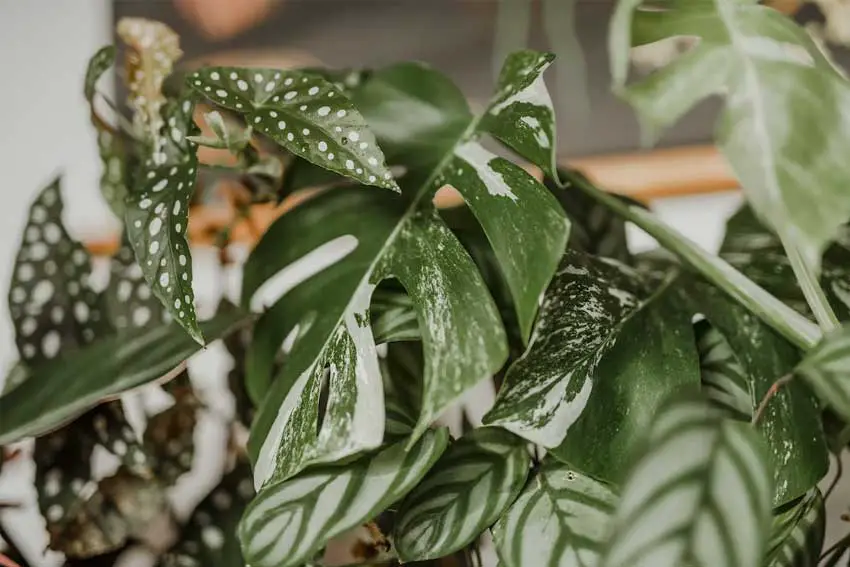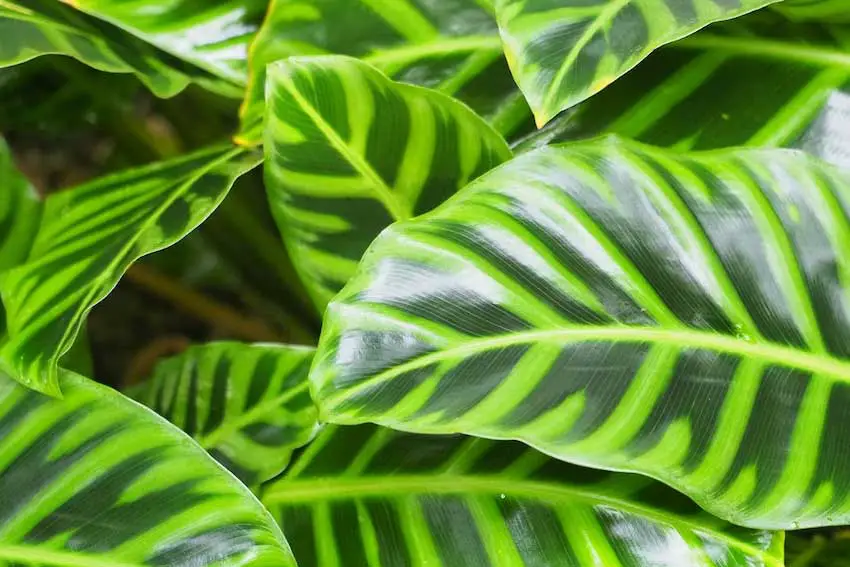Calathea is a tropical American plant that is well-known for its beautiful variegated plant. They grow in a greenhouse or indoors and are usually easy to care for and maintain. However, you may encounter some common issues if you have Calathea houseplants.
Calathea plant leaves curling like jude is one of the most common problems for this plant. This might be a concerning issue if Calathea leaves start curling or folding. So, you have to find out the reason first why this is happening and afterward take necessary actions to solve it.
Calathea leaves curling (like an olive tree) may happen due to different reasons such as high temperature, improper watering, low humidity, bad soil composition, etc. Here, we’ll explain various causes of Calathea plant leaves curling and its remedy (like paddle).
Why Are My Calathea Plant Leaves Curling and How to Fix It?

Calathea plants come in versatile types. Some of them show curling problems frequently such as Calathea Ornata, Calathea pinstripe, Calathea Peacock, Calathea Makoyana, Calathea Zebrina, etc. Let’s know the key reasons.
1. Lack of Humidity
Calathea plants grow well in moist soil and environments. They originated from the tropical forest of Brazil where they get ample humidity. So, it’s important to maintain at least 50% of moisture for the ideal growth of the Calathea plants and their optimum thrive level is found when moisture is 70 to 80%.
If the plants get lesser moisture than below 50% that may cause different problems for the plants like curling leaves inwards (as in the case of curry leaves).
How to Solve This?
If Calathea plants suffer from dehydration or low humidity, you can fix the problem easily by keeping the affected plants indoors. Plants on trays filled with pebbles are another good way to reduce Calathea plants’ dehydration. You can also invest in a plant humidifier so plants get proper moisture.
2. Underwatering Calathea
Lack of water might be another vital reason why your Calathea Ornata shows curl in the leaves. Due to underwatering, plants’ leaves may curl (same as yucca) inwards. Dry soil may damage the Calathea plants’ roots which could cause the dropping of the beautiful foliage and curling. Browning the leaves is also a sign that means Calathea plants need water.
How to Solve This?
It’s best to water the Calathea plants daily from the bottom sewage holes. Put water in a bucket or sink so that plants can soak water from there for at least half an hour regularly.
But never splash water in the leaves, especially when humidity is high. You can also prune the damaged leaves so they get healthier soon.
3. Overwatering
Lack of drainage or overwatering may also cause root rot in the Calathea plants. Due to overwatering, you may see yellowing foliage, wilting, and curling. Although, Calathea plants grow well in moisture, still waterlogging isn’t good for them.
How to Solve This?
Excess water should be drained out through the drainage holes. If the base of the plant turns black, this will indicate the severity of the problem. And in this case, you may re-pot the plants by adding coconut coir and perlite.
Soft and rotted roots can be pruned to prevent the spreading of the problem. To avoid overwatering, you can use a moisture meter.

4. Water Quality
If there are lots of minerals in the water, Calathea Ornata plants may curl. It has two signs- yellow leaves edges and buildup salt on the soil top. In this case, you should change the water soon. An excessive amount of minerals in the water such as fluoride, salts, and calcium carbonate may harm the plants.
How to Solve This?
Flush the soil with warm water if there is salt build-up in the soil. Change the tap water into distilled and filtered water, and harvest rainwater.
5. Soil Conditions for Calathea
The soil used in the Calathea Peacock plants should be moist but not to be soggy. So, the soil should have peat or coco coir, orchid bark, grit, and perlite to allow water to drain easily. Pre-made soil might be a good option than mixing soil at home.
How to Solve This?
It’s recommended to use quality soil for Calathea plants that have proper airing and water drainage.
6. Overfertilization
Calathea Pinstripe plants require fertilization (like citrus) once a month during the growing season like early spring to late summer. If you apply excess fertilizer, plants may pull lots of moisture from the roots, which will cause them not to absorb ample water and afterward result in burning and curling the leaves.
How to Solve This?
Put the Calathea plants in the running water for 10 minutes to flush away the excess salts. Make sure the pot drainage holes are working well to drain out the extra salt water from the pot. After that, apply half a dose of fertilizers per month.

7. Incorrect Temperature
The ideal temperature to grow Calathea plants is between 600F to 800F. Too high temperature or very low weather may harm the Calathea plants. If you keep the plants in cold, the leaves might be curled. Check the temperature of the room and keep it below the recommended temperature.
How to Solve This?
To protect Calathea from cold or hot weather, you can move the plants indoors. You can also use shade cover to protect plants from excessive low or high temperatures. An air conditioner might be helpful to control the room temperature.
8. Excess Sunlight
Too much sunlight is harmful to Calathea plants as they prefer medium bright light. If you put the Calathea plants in direct sunlight, the beautiful foliage may burn and scorch.
How to Solve This?
Shift the plants to a shaded area or low-light spot like indoors. But don’t move them in completely dark places. Place the plants’ northeast-facing window but use shade cloth to avoid heavy sun rays.
9. Pests and Diseases
Calathea plants’ leaves may be curled like aloe due to the invasion of pests or diseases. Some of the culprits of pests that may damage the Calathea plants are whiteflies, thrips, spider mites, fungus gnats, mealybugs, scales, etc. The magnifying lens might be helpful to identify the pests easily.
If Calathea Makoyana plants are infested by spider mites there are two signs- Curling in leaves and webbing in the plants.
How to Solve This?
Bring the Calathea plants to shady and humid places. Wash the infested foliage with insecticidal soap. You can apply neem oil to kill the culprits’ pests. Also, isolate the infested plants from the good ones. Pruning the damaged leaves might be helpful to regain healthy leaves soon.
10. Natural Movement of Calathea
Calathea plants fold up at night to store their energy, this is a natural process. So, you may see leaves curling inwards at night and outwards at day time. It may seem the leaves are unhealthy but this isn’t true actually. So, it’s quite difficult to decide on leaves curling (same for spinach) after seeing them at night. After repotting the Calathea plants curling may also be seen sometimes.
How to Solve This?
Observe the leaves for a couple of days both at night and day continuously to understand if is it happening naturally or not. If it’s natural don’t worry.
Conclusion on Calathea Plant Leaves Curling
So, how is Calathea plant leaves curling? This may happen due to various reasons such as lack of humidity, improper watering, bad quality soil, overfertilization, improper sunlight, excessive temperature, pest invasion, and many more.
Some of the general solutions for these problems are maintaining the humidity at more than 50%, watering the plants daily, and keeping the plants in shady places. Hopefully, you can now take the necessary actions to prevent Calathea leaves from curling.
A short video on calathea plant leaves curling and solutions:

I’m Shofi, a passionate gardener and blogger. I have 10+ years of experience in gardening and hold certifications in horticulture and garden design. I share my knowledge and skills through my garden blog to inspire and educate others on the joys of gardening. I try to provide valuable information and create a community for gardeners of all levels to connect and learn. My ultimate goal is to inspire others to start their own gardens and connect with nature.
